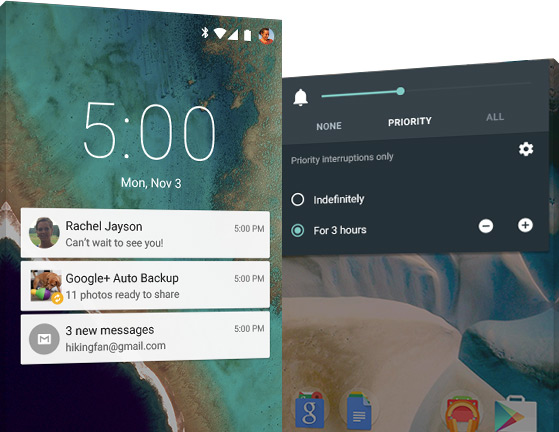Everything You Need To Know About Android 5.0 Lollipop
After many months of speculation, Android L has finally received an official sweets name: Lollipop. The version number is also officially called "5.0,” which makes sense considering Google is calling this version its "most ambitious release on Android with over 5,000 new APIs for developers."
Material Design
The first thing users will notice is the visual improvements. Android Lollipop adopted the "Material Design" style that Google talked about at I/O 2014, and it's also the design language that Google wants all Android apps to use across multiple form factors.
Material design is a mix of colorful flat user interfaces with shadows that give them depth and hierarchy, which makes apps more intuitive to use. Another big part of the Material Design philosophy is "responsive" motion for the "enchantment" factor that Google has mentioned in the past as a design principle they care about.
Notifications
Android's notifications have always been ahead of the competition, and with Lollipop, the notification system gets even more advanced. One of the changes is that you can now see your notifications directly on the lockscreen, and even reply to them.
You can now let only a few notifications through when you don't want to get disturbed, and the OS can also figure out how to rank your notifications intelligently in order of importance.
Battery Life
Android 5.0 should give devices a nice boost in battery life thanks to a new runtime called ART, which allows apps to compile natively on the device, thus increasing performance and reducing power consumption at the same time.
The Lollipop version also comes with "Project Volta," which is a battery saver mode, that can extend use by 90 minutes, and a new Job Scheduler API that, when used by developers in their apps, can reduce the power consumption of those apps. Users can also now see in the Battery settings how much time they have left before they need to charge the device again.
Get Tom's Hardware's best news and in-depth reviews, straight to your inbox.
Security
As promised a few weeks ago, Android Lollipop devices will be encrypted out of the box. This should help reduce the possibility of having your device stolen, while also ensuring that thieves can't get access to it. One extra bonus of this feature is that when you sell your device, the data won't be recoverable. Right now, even if you wipe the phone using the factory reset, data can still be recovered.
A new feature we've seen on the Moto X before is the ability to secure your device by pairing it with a Bluetooth-enabled wearable, such as an Android Wear smartwatch or even your car. This new feature is appropriately called Android Smart Lock.
Device Sharing
Android 5.0 finally introduces some long awaited features such as the ability to have multiple accounts on the same device, making it easy especially for people with kids to share their phones or tablets with their children. This feature has existed on tablets in a more limited fashion, but it's just as necessary on smartphones.
Android Lollipop also brings Screen Pinning which lets you set up a PIN, so friends or family members can see only what you're allowing them to see, but nothing else. This can be useful when you want to show someone an app or how your new phone works, but you don't want them to look through your pictures as well.
New Quick Settings
Another simple, yet painfully needed feature in Android that arrived in Lollipop is a quick setting for the flashlight. Everyone needs the flashlight every now and then, and when you need it most you don't want it buried in three levels of settings. Cast screen, screen rotation and hotspot controls have also been introduced.
Adaptive brightness gets an improvement, too. Now you can manually set brightness to a certain level, and it will auto-adjust itself based on the new lighting environments from there. Before this, either adaptive brightness was always too high or too low, or you were forced to use manual brightness controls.
Performance
As mentioned above, Lollipop introduces the new Android Runtime that, according to Google, brings up to 4x performance improvements, smoother UI for complex applications, and more compact background applications.
The new runtime also supports 64-bit automatically for all Java applications, and on all three major chip architectures: ARM, MIPS and x86. Apps written with C++ will need to be compiled for 64-bit. Google has already done that for its own first-party apps such as: Chrome, Gmail, Calendar, Google Play Music and more.
Audio
Android has long been criticized for its high-latency audio. Audio latency has improved greatly in Android 5.0, to the point where music or recording apps can actually get the sound in real-time. Professional audio apps can also use 5.1 and 7.1 channels now. Another feature that Lollipop brings is support for USB audio, so you can connect amplifiers and mixers to your Android device.
Graphics
The new Android version comes with support for the latest OpenGL ES 3.1 graphics API, and it also includes Google's own Android Extension Pack that adds a few extra features from the higher level OpenGL 4.x, making Android devices ready for desktop-class gaming.
With hardware like Tegra K1, we can finally say that "desktop-class gaming" on mobile isn't just misleading marketing. Epic Games has also recently added Android support to its Unreal 4 engine, so developers should be able to create some graphically intensive games in the next year or two, for Android 5+ devices.
Photography
One of the most exciting changes in Android 5.0 is the overhauling of the Camera API. Android's camera software has always been limited in features and also in terms of performance, not doing justice to the camera hardware it was running on.
Android Lollipop should finally fix that. The new Camera2 API is fast enough to take advantage of the full resolution of the sensor at 30 fps-burst mode. This means HDR or other such computational photography should be much "cheaper" to do on Android Lollipop devices. The new API also allows for much more fine-grained control of the sensor, lens and flash per individual frame.
The new camera software has support for YUV and Bayer RAW image files, which means get ready for third-party camera apps to push the limit even further on Android, beyond even what the new stock camera software can do.
Android 5.0 is Google's biggest Android release ever, and it shows. It comes with a much more modern design language, great performance improvements system-wise and camera-wise, a plethora of new features, and 5,000 new APIs developers can start using in their new apps. The new Nexus 6 and Nexus 9 devices are where this new software will be showcased at its best.
Follow Kevin Parrish @exfileme. Follow us @tomshardware, on Facebook and on Google+.
Lucian Armasu is a Contributing Writer for Tom's Hardware US. He covers software news and the issues surrounding privacy and security.
-
dovah-chan ART is not actually a new runtime; its been around for a while. It's only just now officially replacing the dated Dalvik runtime and is going to give a pretty big boost on battery life now. The only reason they've finally decided to make the switch is because ART has become a lot more stable ever since its conception and is pretty mature now.Reply -
ferooxidan http://www.cnet.com/products/google-android-5-0-lollipop/Reply
Well I read it first there from my G+ on my Nexus 5. So, who is copying who? the article -
wiad I find it funny how when Apple adds a feature to ios that has already been implemented on Android, people are always very quick to point it out and criticize them. However when Android adds a feature that is already on ios, such as the flashlight quick setting or responding to notifications straight from the lock screen, nobody is quick to point out that ios already has this feature. Just an observation but maybe I am missing something.Reply -
velocityg4 How about also changing the rules so that vendors have to use a vanilla Android and provide drivers to Google. That way Google can make an installer that can simply install a vanilla Android on release day. Then clear out unnecessary drivers after installation.Reply
That way people can have an up to date Android phone that is good for more than 18 months with a current OS. I was going to buy an Xperia Z until I found out that when you root a phone you can't just simply install a vanilla Android. Rather you have to get a modified build.
If my PC meets the specs I can install the latest Windows or Linux distro. Not wait for a special build from the vendor. Why can't the phone be the same? It's just a tiny PC. -
lpedraja2002 I'm pretty excited for this I got a very noticeable performance boost with Kit Kat on my LG G2 but I know it can be even smoother like my Windows Phone and iPhone. The battery life also improved a bit for me which was already great so I'm very eager to see if it lasts even more.Reply -
therealduckofdeath @wiad, This is literally a messaging specific feature that Apple copied from Samsung. Just like most other features Apple has "innovated" the last 4-5 years.Reply

